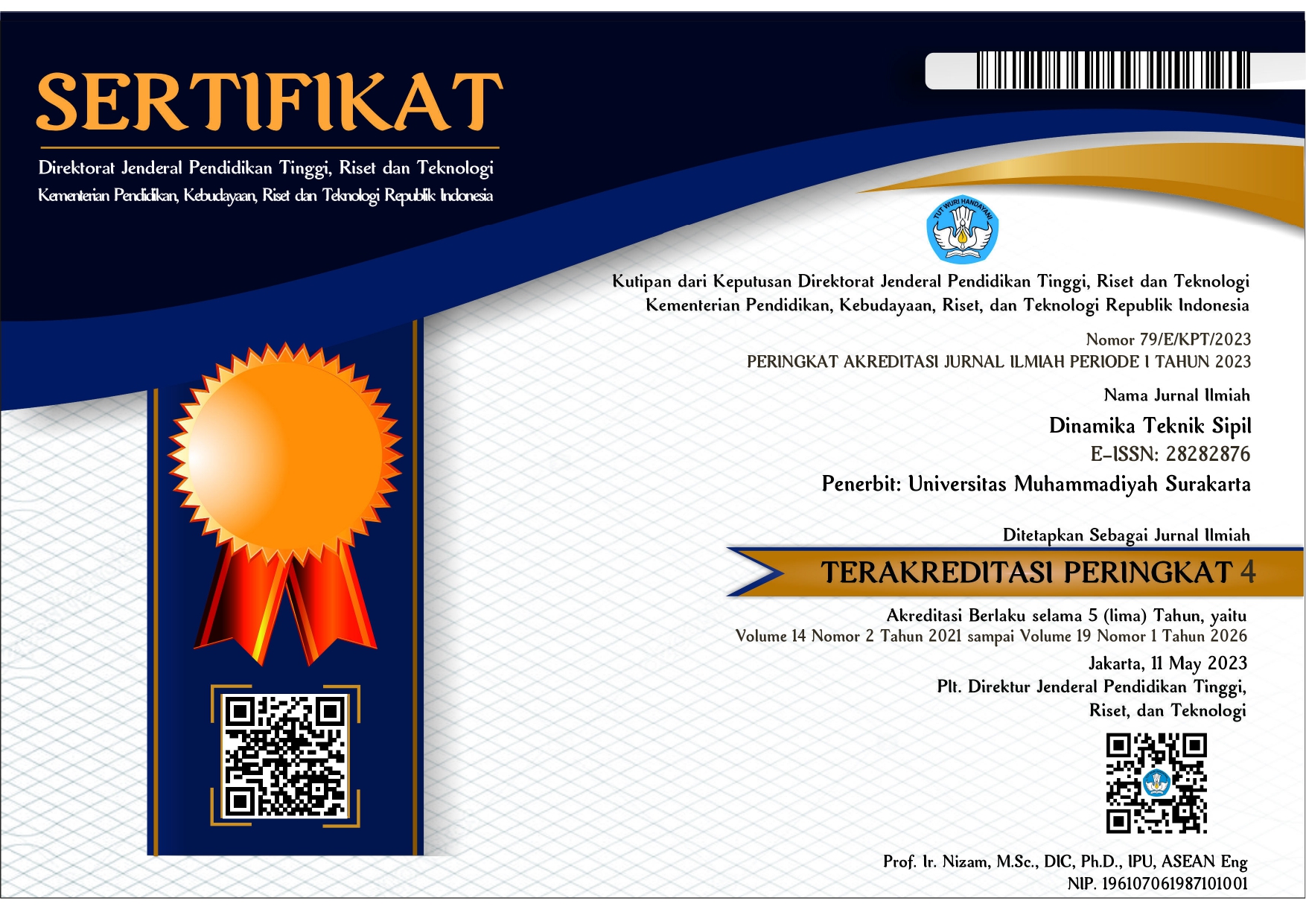Tsunami Inundation Modeling and Hazard Mapping Using GIS in Sawarna Beach, Banten Province
DOI:
https://doi.org/10.23917/dts.v18i1.10617Keywords:
DEM, GIS, hazard index, tsunami inundation, vulnerability mappingAbstract
Tsunamis pose significant hazards to coastal areas, particularly in tectonically active regions like the southern coast of Java. This study models tsunami inundation at Sawarna Beach, Banten Province, using a quantitative spatial analysis approach. By integrating Digital Elevation Model (DEM) data from DEMNAS and land cover data from BIG, a tsunami hazard index is generated through slope analysis, surface roughness coefficients, and cost distance modeling within a GIS framework. The analysis reveals that areas with low surface roughness and gentle slopes are more prone to deep inland tsunami inundation. Vulnerability mapping under simulated tsunami heights (5m, 10m, 15m, and 30m) shows that hazard zones significantly increase with wave height, with the highest exposure at 30m reaching nearly 15 million m². The study underscores the importance of accurate topographic data for disaster mitigation planning and provides essential recommendations for local stakeholders in land use and infrastructure development. These findings serve as a valuable reference for enhancing tsunami preparedness and resilience in coastal communities.
Downloads
References
Adriano, B., Mas, E., Koshimura, S., & Gokon, H. 2020. Validation of Tsunami Numerical Model Using Observed Data of Building Damage and Flow Depth in the 2018 Sulawesi Tsunami. Coastal Engineering Journal, 62(1), 87–102. https://doi.org/10.1080/21664250.2020.1723873
Badan Informasi Geospasial. 2025. Ina-Geoportal. Indonesia.go.id. https://tanahair.indonesia.go.id/portal-web/unduh
Berryman, K. 2005. Review of Tsunami Hazard and Risk in New Zealand. https://www.hbemergency.govt.nz/assets/Documents/Hazard-Reference-Documents/review-of-tsunami-hazard-and-risks-in-nz-sept-05.pdf
BNPB. 2012. Peraturan Kepala Badan Nasional Penanggulangan Bencana Nomor 02 Tahun 2012 tentang Pedoman Umum Pengkajian Risiko Bencana. https://bpbd.natunakab.go.id/wp-content/uploads/2024/03/Peraturan-Kepala-BNPB-No-02-Tahun-2012.pdf
BNPB. 2023. Risiko Bencana Indonesia: Memahami Risiko Sistemik di Indonesia. Pusat Data, Informasi, dan Komunikasi Kebencanaan BNPB.
Budiman, M. J., Sutoyo, & Syafiudin, M. F. 2024. Pemetaan Kerentanan Bahaya Tsunami dengan Pemodelan Inundasi (Studi Kasus: Kabupaten Bantul). Jurnal Teknik Sipil Dan Lingkungan, 9(2), 157–166. https://doi.org/10.29244/jsil.9.2.157-166
Fitriani, L., Sutrisno, A., & Hidayat, R. 2024. Scenario-Based Tsunami Hazard Assessment Using Multi-Wave Simulations in Southern Banten. Geoscience Frontiers. https://doi.org/10.1016/j.gsf.2024.101572
Goto, K., Chagué-Goff, C., Fujino, S., & Nishimura, Y. 2011. Inundation Distances and Flow Depths of Recent Tsunamis Inferred from Geological Data. Earth-Science Reviews, 107(1-2), 38–51. https://doi.org/10.1016/j.earscirev.2011.03.002
Gusman, A. R., Tanioka, Y., & Latief, H. 2023. Influence of Topographic Roughness and Vegetation on Tsunami Wave Energy Dissipation Inland. Journal of Geophysical Research: Oceans, 128(2), e2022JC018926. https://doi.org/10.1029/2022JC018926
Iswari, M. Y., & Anggraini, K. 2018. DEMNAS: Model Digital Ketinggian Nasional untuk Aplikasi Kepesisiran. OSEANA, 43(68), 68–80. https://doi.org/10.14203/oseana.2018.Vol.43No.4.2
Koesoemadinata, R. P. 2020. An Introduction into the Geology of Indonesia (Vol. 1). Ikatan Alumni Teknik Geologi ITB.
McCaffrey, R. 2008. Global Frequency of Magnitude 9 Earthquakes. Geology, 36(3), 263. https://doi.org/10.1130/g24402a.1
Mori, N., Takahashi, T., Yasuda, T., & Yanagisawa, H. 2011. Survey of 2011 Tohoku Earthquake Tsunami Inundation and Run-Up. Geophysical Research Letters, 38(7). https://doi.org/10.1029/2011GL049210
Prasetya, G. S., Imamura, F., & Gusman, A. R. 2021. High-Resolution Tsunami Inundation Modeling and Hazard Mapping for the Southern Coast of Java, Indonesia. Natural Hazards, 109(3), 2147–2169. https://doi.org/10.1007/s11069-021-04934-3
Putra, A. A., Wibowo, H., & Hadi, S. 2022. Integrating DEMNAS and Land Use Data for Tsunami Risk Zoning in Pangandaran, Indonesia. International Journal of Disaster Risk Reduction, 72, 102845. https://doi.org/10.1016/j.ijdrr.2022.102845
Rahayu, H. P., Comfort, L. K., Khoirunnisa, D., & Nurhasanah, D. 2024. Need Assessment for Coastal Tourism Area in the Face of Tsunami Risk: The Case of Pangandaran. International Journal on Advanced Science Engineering Information Technology, 14(2), 563–574.
Sarah, R., Awaluddin, M., & Hadi, F. 2024. Analisis Bahaya Tsunami di Kota Cilegon Menggunakan Sistem Informasi Geografis. Jurnal Geodesi Universitas Diponegoro Januari, 13(1), 58–64.
Sundar, V., Sannasiraj, S. A., Murali, K., & Sriram, V. 2020. Tsunami: Engineering Perspective for Mitigation, Protection and Modelling (Vol. 50). World Scientific Publishing. https://books.google.co.id/books?id=z3fpDwAAQBAJ
Suri, S. A., Sutoyo, & Syafiudin, M. F. 2024. Analisis Dampak Bencana Tsunami dan Perencanaan Jalur Evakuasi (Studi Kasus: Kabupaten Sukabumi). Jurnal Teknik Sipil Dan Lingkungan, 9(1), 11–20. https://doi.org/10.29244/jsil.9.1.11-20
Tanioka, Y., Gusman, A. R., Satake, K., & Latief, H. 2018. Tsunami Scenario Simulations for the Java Subduction Zone Using New Seismic and Bathymetric Data. Journal of Disaster Research, 13(6), 1082–1091. https://doi.org/10.20965/jdr.2018.p1082
Tonini, R., Di Manna, P., Lorito, S., Selva, J., Volpe, M., Romano, F., Basili, R., Brizuela, B., Castro, M. J., de la Asunción, M., Di Bucci, D., Dolce, M., Garcia, A., Gibbons, S. J., Glimsdal, S., González-Vida, J. M., Løvholt, F., Macías, J., Piatanesi, A., & Pizzimenti, L. 2021. Testing Tsunami Inundation Maps for Evacuation Planning in Italy. Frontiers in Earth Science, 9. https://doi.org/10.3389/feart.2021.628061
USGS. 2019. Search Earthquake Catalog. Usgs.gov. https://earthquake.usgs.gov/earthquakes/search/
Wahyudi, A., Priadmodjo, A., Aksa, A., & Islaha, F. A. 2024. Pemetaan Skenario Genangan Tsunami Berbasis Pemodelan Spasial. Jurnal Penelitian Pendidikan Geografi, 9(1), 44–51. http://creativecommons.org/licenses/by-nc/4.0
Wei, Y., Bernard, E. N., Titov, V., Moore, C., Spillane, M., Hopkins, M., & Mofjeld, H. 2013. Inundation Modeling and Mapping of Tsunami Hazards in the US Pacific Northwest. Natural Hazards, 65, 253–276. https://doi.org/10.1007/s11069-012-0350-y
Yudhicara, Cipta, A., Maemunah, I., Lewu, A. P., & Nurfalah, F. 2023. Katalog Tsunami Indonesia Tahun 416 - 2021 (A. Budianto, S. Hidayati, & Supartoyo, Eds.; pp. 52–65). Pusat Vulkanologi dan Mitigasi Bencana Geologi.
Downloads
Submitted
Accepted
Published
Issue
Section
License
Copyright (c) 2025 Muhammad Amin Arya Bima, Thema Arrisaldi, Kanya Kirana Ramadhani Nurapita, Puji Pratiknyo

This work is licensed under a Creative Commons Attribution-NonCommercial 4.0 International License.









